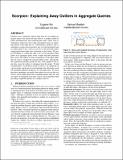Scorpion: Explaining Away Outliers in Aggregate Queries
Author(s)
Wu, Eugene; Madden, Samuel R.
Downloadscorpion-vldb13.pdf (5.987Mb)
OPEN_ACCESS_POLICY
Open Access Policy
Creative Commons Attribution-Noncommercial-Share Alike
Terms of use
Metadata
Show full item recordAbstract
Database users commonly explore large data sets by running aggregate queries that project the data down to a smaller number of points and dimensions, and visualizing the results. Often, such visualizations will reveal outliers that correspond to errors or surprising features of the input data set. Unfortunately, databases and visualization systems do not provide a way to work backwards from an outlier point to the common properties of the (possibly many) unaggregated input tuples that correspond to that outlier. We propose Scorpion, a system that takes a set of user-specified outlier points in an aggregate query result as input and finds predicates that explain the outliers in terms of properties of the input tuples that are used to compute the selected outlier results. Specifically, this explanation identifies predicates that, when applied to the input data, cause the outliers to disappear from the output. To find such predicates, we develop a notion of influence of a predicate on a given output, and design several algorithms that efficiently search for maximum influence predicates over the input data. We show that these algorithms can quickly find outliers in two real data sets (from a sensor deployment and a campaign finance data set), and run orders of magnitude faster than a naive search algorithm while providing comparable quality on a synthetic data set.
Date issued
2013-06Department
Massachusetts Institute of Technology. Department of Electrical Engineering and Computer ScienceJournal
Proceedings of the VLDB Endowment
Publisher
Association for Computing Machinery (ACM)
Citation
Eugene Wu and Samuel Madden. 2013. Scorpion: explaining away outliers in aggregate queries. Proc. VLDB Endow. 6, 8 (June 2013), 553-564.
Version: Author's final manuscript
ISSN
21508097